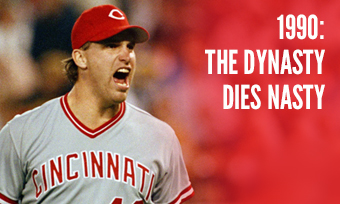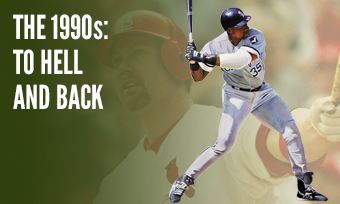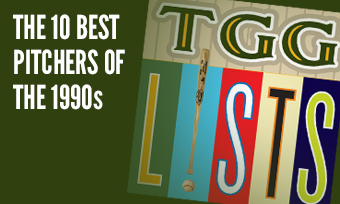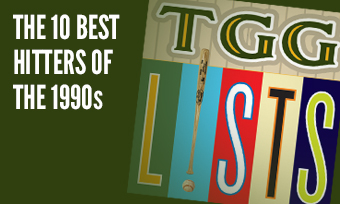The Yearly Reader
Leaders and Honors, 1990
Our list of baseball’s top 10 hitters and pitchers in both the American League and National League for the 1990 baseball season, as well as the awards and honors given to the game’s top achievers of the year.
The National League’s Top 10 Hitters, 1990
Bold type in brick red indicates league leader.
1. Barry Bonds, Pittsburgh
Key Numbers: .301 average, 104 runs, 32 doubles, 33 home runs, 114 RBIs, 93 walks, 52 stolen bases, .565 slugging percentage.
Dogged by erratic performance through his first four years in the majors, maddened by an arbitration defeat and embarrassed that no team wanted to trade for him, Bonds finally and absolutely came alive—winning his first of a record eight MVPs.
2. Ryne Sandberg, Chicago
Key Numbers: .306 average, 116 runs, 188 hits, 30 doubles, 40 home runs, 100 RBIs, 25 stolen bases.
One wondered how fans of the Cubs—surprised by Ryne Sandberg’s 30 homers in 1989—felt about his NL-high 40 in 1990.
3. Ron Gant, Atlanta
Key Numbers: .303 average, 107 runs, 174 hits, 34 doubles, 32 home runs, 84 RBIs, 33 stolen bases.
Gant, whose 1988 rookie star fell all the way down to Class-A ball in 1989, rebounded all the way back up and then some.
4. Bobby Bonilla, Pittsburgh
Key Numbers: .280 average, 112 runs, 175 hits, 39 doubles, 7 triples, 32 home runs, 120 RBIs, 15 sacrifice flies.
Barry Bonds’ emergence made life statistical easier for Bonilla, but more difficult in the MVP race (he finished second behind Bonds in the vote.)
5. Lenny Dykstra, Philadelphia
Key Numbers: .325 average, 106 runs, 192 hits, 35 doubles, 9 home runs, 60 RBIs, 89 walks, 33 stolen bases, .418 on-base percentage.
Putting on the muscle—much of it through steroids—the wild, confrontational Dykstra used it to improve his average by nearly 100 points while enhancing his pugilism, as Dodgers catcher Rick Dempsey found out during an August brawl at Los Angeles.
6. Kal Daniels, Los Angeles
Key Numbers: 130 games, .296 average, 81 runs, 27 home runs, 94 RBIs.
The fleetingly good Daniels matched Eddie Murray at the top of the Dodgers’ power chain, and twice knocked in six runs in a game.
7. Eddie Murray, Los Angeles
Key Numbers: .330 average, 96 runs, 184 hits, 26 home runs, 95 RBIs, 82 walks, 21 intentional walks.
When Willie McGee was traded from the Cardinals to the A’s with a NL-leading .335 average on August 29, Murray was the guy who took the best shot at topping the mark before time ran out. Despite hitting .411 from September 1 on, he couldn’t get there.
8. Darryl Strawberry, New York
Key Numbers: .277 average, 92 runs, 37 home runs, 108 RBIs, 15 stolen bases.
Strawberry gave it all he had for the Mets in what most everyone knew would be his last year in New York.
9. Eric Davis, Cincinnati
Key Numbers: 127 games, .260 average, 84 runs, 26 doubles, 24 home runs, 86 RBIs, 21 stolen bases.
Davis barely hit over .200 for much of the year before the introduction of eye contacts finally launched him on a late-season groove.
10. David Justice, Atlanta
Key Numbers: 127 games, .282 average, 76 runs, 28 home runs, 78 RBIs, 11 stolen bases.
The NL Rookie of the Year gave life to a morbid (65-97) Braves team on the precipice of a shocking turnaround.
The American League’s Top 10 Hitters, 1990
1. Rickey Henderson, Oakland
Key Numbers: 136 games, .325 average, 119 runs, 33 doubles, 28 home runs, 61 RBIs, 97 walks, 65 stolen bases, .439 on-base percentage.
Sometimes it’s about being in the right mood. Henderson, known for flicking the switch on and off, was never happier with the powerful A’s—and thus never better, winning his sole career MVP.
2. Cecil Fielder, Detroit
Key Numbers: .277 average, 104 runs, 25 doubles, 51 home runs, 132 RBIs, 90 walks, 182 strikeouts, .592 slugging percentage.
Returning from a brief but highly productive exile in Japan, Fielder became the first American Leaguer since Roger Maris and Mickey Mantle, 29 years earlier, to hit over 50 homers. The damage included a pair of three-homer games—the first of which came in an early-season contest against his old team, the Blue Jays.
3. Fred McGriff, Toronto
Key Numbers: .300 average, 91 runs, 35 home runs, 88 RBIs, 94 walks.
The man who replaced Fielder in Toronto had his first of two .300-.400-.500 seasons: A .300 batting average, .400 on-base-percentage and .500 slugging percentage.
4. Kelly Gruber, Toronto
Key Numbers: .274 average, 92 runs, 36 doubles, 6 triples, 31 home runs, 118 RBIs, 14 stolen bases.
The 28-year-old Houston native followed McGriff as the next big Blue Jays star—but the shine would be brief as he quickly tailed off and be out of the majors after 1993.
5. George Brett, Kansas City
Key Numbers: .329 average, 82 runs, 179 hits, 45 doubles, 7 triples, 14 home runs, 87 RBIs.
The fountain of youth was overflowing for the 37-year-old Brett; he hit .384 in the second half, became the only hitter to win batting titles in three different decades, hit for his second career cycle, and for the seventh and last time collected two triples on one game.
6. Jose Canseco, Oakland
Key Numbers: 131 games, .274 average, 83 runs, 37 home runs, 101 RBIs, 158 strikeouts, 19 stolen bases.
His 1989 campaign more than half-wiped out by injury, Canseco strained to return to his 1988 MVP form, performing well but obviously putting more emphasis on swinging for the upper deck with every at-bat.
7. Ken Griffey Jr., Seattle
Key Numbers: .300 average, 91 runs, 179 hits, 28 doubles, 7 triples, 22 home runs, 80 RBIs, 16 stolen bases.
In his sophomore season, Junior got off to a roaring start (.346 average, 10 home runs by the end of May) before ebbing, but there was increasingly less doubt that the kid born on the same date and place as Stan Musial might soon equal him in legend.
8. Mark McGwire, Oakland
Key Numbers: .235 average, 87 runs, 39 home runs, 108 RBIs, 110 walks.
Like Jose Canseco, the muscular McGwire was still looking to replicate his breakout success (from 1987) and, at least in the power numbers, mostly succeeded. Of his 39 homers, 25 were hit away from the Oakland Coliseum.
9. Wade Boggs, Boston
Key Numbers: .302 average, 89 runs, 187 hits, 44 doubles, 5 triples, 6 home runs, 63 RBIs, 87 walks, 19 intentional walks.
Boggs wouldn’t hit below .300 until 1992, but he came awfully close in 1990 as a late-September slump nearly put him under the milestone mark.
10. Julio Franco, Texas
Key Numbers: .296 average, 96 runs, 172 hits, 27 doubles, 11 home runs, 69 RBIs, 31 stolen bases.
At age 32—and with 14 major league seasons still ahead of him—the Dominican second baseman enjoyed his best moment of the year when he was named the All-Star Game MVP at Wrigley Field.
The National League’s Top 10 Pitchers, 1990
1. Doug Drabek, Pittsburgh
Key Numbers: 2.76 ERA, 22 wins, 6 losses, .786 win percentage, 33 starts, 231.1 innings.
Yankees fans shook their heads yet again watching Drabek, another once-pinstriped prospect, succeed elsewhere as he became only the second Pirate (after Vern Law in 1960) to win a Cy Young Award. In a year with a record eight no-hitters, Drabek nearly made it nine—but missed by one out on August 3 at Philadelphia.
2. Ed Whitson, San Diego
Key Numbers: 2.60 ERA, 14 wins, 9 losses, 32 starts, 228.2 innings, 47 walks.
At age 35, Whitson enjoyed a final hurrah, posting a personal-best ERA and belting his only career home run before succumbing to shoulder surgery a year later.
3. Frank Viola, Minnesota
Key Numbers: 2.67 ERA, 20 wins, 12 losses, 35 starts, 249.2 innings, 11 wild pitches, 26 stolen bases.
In his first full year at Shea Stadium after years of relatively congenial support in Minnesota, Viola kept the demanding Mets fans happy with his second (and last) 20-win output.
4. Zane Smith, Montreal-Pittsburgh
Key Numbers: 2.55 ERA, 12 wins, 9 losses, 31 starts, 215.1 innings, 50 walks, 27 stolen bases allowed, 34 grounded into double plays.
After a 6-23 record at Atlanta over his previous two years, Smith showed what he could do when paired with a winner at Pittsburgh.
5. Danny Darwin, Houston
Key Numbers: 2.21 ERA, 11 wins, 4 losses, 2 saves, 2 blown saves, 48 appearances, 17 starts, 162.2 innings, 31 walks.
The last in a flurry of atypical NL ERA titlists, Darwin didn’t even start a game until July; his last start (seven shutout innings against Atlanta on September 28) gave him just enough frames to qualify for the crown.
6. Ramon Martinez, Los Angeles
Key Numbers: 2.92 ERA, 20 wins, 6 losses, .769 win percentage, 33 starts, 12 complete games, 234.1 innings, 22 stolen bases allowed.
The 22-year-old rookie struck out a major league season-high 18—something his Hall-of-Fame brother, Pedro Martinez, would never accumulate in a game. Martinez’s terrific showing came six years after he pitched for the Dominican Olympic team at 16.
7. Jose Rijo, Cincinnati
Key Numbers: 2.70 ERA, 14 wins, 8 losses, 29 starts, 197 innings, 5 balks.
Recovered from a lower back fracture, Rijo reclaimed his steady level of efficient play, improving to season’s end and into the postseason (winning World Series MVP honors).
8. Greg Maddux, Chicago
Key Numbers: 3.46 ERA, 15 wins, 15 losses, 35 starts, 237 innings, 27 grounded into double plays.
Maddux had to work extra hard to earn his results thanks to lousy Cubs defense; a NL-high 23 runners reached on errors against him, and 25 of his 116 runs allowed were unearned. (As usual, the slick-gloved ace made no errors himself.)
9. Dwight Gooden, New York
Key Numbers: 3.83 ERA, 19 wins, 7 losses, .731 win percentage, 34 starts, 232.2 innings, 60 stolen bases allowed, 16 caught stealing/picked off.
Dr. K. counted up his second-highest win total—missing out on a chance for #20 when the Pirates knocked him around in his last start—but the amazing thing is that he survived the year despite conceding a major league-record 60 stolen bases.
10. Dennis Martinez, Montreal
Key Numbers: 2.95 ERA, 10 wins, 11 losses, 32 starts, 226 innings, 49 walks.
Though his misleading win-loss record didn’t indicate it, the 36-year-old Martinez continued a career rebirth in Montreal after his life was nearly derailed by excessive drinking in Baltimore. It was his only below-.500 finish record in six years at Canada.
The American League’s Top 10 Pitchers, 1990
1. Roger Clemens, Boston
Key Numbers: 1.93 ERA, 21 wins, 6 losses, .778 win percentage, 31 starts, 4 shutouts, 228.1 innings.
Damn that Dave Stewart: Clemens was 21-3 when he didn’t face the Oakland ace—and 0-4 when he did (including his ejected Game Four ALCS loss).
2. Dave Stewart, Oakland
Key Numbers: 2.56 ERA, 22 wins, 11 losses, 36 starts, 11 complete games, 4 shutouts, 267 innings, 23 grounded into double plays.
In an emerging era of starting pitchers being handled like fine china, Stewart pitched into extra innings three times.
3. Chuck Finley, California
Key Numbers: 2.40 ERA, 18 wins, 9 losses, 32 starts, 236 innings, 15 stolen bases allowed, 18 caught stealing/picked off, 22 grounded into double plays.
It was a knockout year for Chuck Finley, one of baseball’s more handsome pitchers—so long as he wasn’t knocked about by girlfriend-actress-kickboxer Tawny Kitaen, who he met in 1990.
4. Dave Stieb, Toronto
Key Numbers: 2.93 ERA, 18 wins, 6 losses, .750 win percentage, 33 starts, 208.2 innings, 10 hit-by-pitches.
After throwing five previous one-hitters—three of them no-hitters/perfect games lost with two outs in the ninth—Stieb finally got his long-sought no-no at Cleveland on September 2.
5. Dennis Eckersley, Oakland
Key Numbers: 0.61 ERA, 4 wins, 2 losses, 48 saves, 2 blown saves, 63 appearances, 73.1 innings, 4 walks.
Eck hit peak as a closer, not allowing his first run until May 25 and his first walk until June 12. His WHIP (walks and hits allowed per game) matched his ERA…at 0.61.
6. Bobby Thigpen, Chicago
Key Numbers: 1.83 ERA, 4 wins, 6 losses, 57 saves, 8 blown saves, 77 appearances, 86.2 innings, 12 grounded into double plays.
With a little less quality but a little more quantity than Eckersley, Thigpen had the White Sox’ knack of maintaining short leads to thank for smashing the season saves record.
7. Bob Welch, Oakland
Key Numbers: 2.95 ERA, 27 wins, 6 losses, .818 win percentage, 35 starts, 238 innings, 25 grounded into double plays.
Sparky Anderson said every good pitcher has one great year—and so it was for Bob Welch, who flirted with 30 wins.
8. Kevin Appier, Kansas City
Key Numbers: 2.76 ERA, 12 wins, 8 losses, 32 appearances, 24 starts, 185.2 innings.
The 1990s began in Kansas City with a strong rookie campaign from Appier, their best pitcher during a dismal decade for the Royals.
9. Erik Hanson, Seattle
Key Numbers: 3.24 ERA, 18 wins, 9 losses, 33 starts, 236 innings, 10 wild pitches, 18 stolen bases allowed.
At 6”6’, Erik Hanson was, for the moment, the better of several towering young Mariner pitchers—a group that included a young Randy Johnson.
10. Greg Hibbard, Chicago
Key Numbers: 3.16 ERA, 14 wins, 9 losses, 33 starts, 211 innings, 25 grounded into double plays.
Like Hanson in Seattle, Hibbard matched strong numbers with the more heralded hopeful in the White Sox rotation, Jack McDowell (who also finished 14-9).









